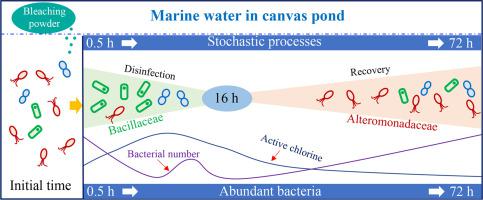Water Research ( IF 11.4 ) Pub Date : 2023-05-27 , DOI: 10.1016/j.watres.2023.120136 Yawen Tang 1 , Huajun Zhang 2 , Jiaojiao Yan 1 , Nan Luo 1 , Xuezhi Fu 1 , Xiaoyu Wu 1 , Jialin Wu 3 , Changjun Liu 4 , Demin Zhang 1

|
Single-bleaching powder disinfection is a highly prevalent practice to disinfect source water for marine aquaculture to prevent diseases. However, due to the decay of active chlorine and the presence of disinfectant resistance bacteria (DRB), the effects of bleaching powder on prokaryotic community compositions (PCCs) and function in marine water remain unknown. In the present study, the source water in a canvas pond was treated with the normal dose of bleaching powder, and the impact on PCCs and functional profiles was investigated using 16S rRNA gene amplicon sequencing. The bleaching powder strongly altered the PCCs within 0.5 h, but they began to recover at 16 h, eventually achieving 76% similarity with the initial time at 72 h. This extremely rapid recovery was primarily driven by the decay of Bacillus and the regrowth of Pseudoalteromonas, both of which are DRB. Abundant community not only help PCCs recover but also provide larger functional redundancy than rare community. During the recovery of PCCs, stochastic processes drove the community assembly. After 72 h, five out of seven identified disinfectant resistance genes related to efflux pump systems were highly enriched, primarily in Staphylococcus and Bacillus. However, 15 out of the 16 identified antibiotic resistance genes (ARGs) remained unchanged compared to the initial time, indicating that bleaching powder does not contribute to ARGs removal. Overall, the findings demonstrate that single-bleaching powder disinfection cannot successfully meet the objective of disease prevention in marine aquaculture water due to the extremely rapid recovery of PCCs. Hence, secondary disinfection or novel disinfection strategies should be explored for source water disinfection.
中文翻译:

评估漂白粉消毒海水的功效:微生物组快速恢复的见解
单一漂白粉消毒是海水养殖源水消毒预防疾病的一种非常普遍的做法。然而,由于活性氯的衰变和消毒剂抗性细菌(DRB)的存在,漂白粉对海水中原核群落组成(PCC)和功能的影响仍然未知。在本研究中,用正常剂量的漂白粉处理帆布池塘的源水,并使用 16S rRNA 基因扩增子测序研究对 PCC 和功能特征的影响。漂白粉在 0.5 小时内强烈改变 PCC,但在 16 小时开始恢复,最终在 72 小时时与初始时间达到 76% 的相似性。这种极快的恢复主要是由芽孢杆菌的腐烂驱动的以及假交替单胞菌的再生,两者都是 DRB。丰富的社区不仅有助于PCC的恢复,而且比稀有的社区提供更大的功能冗余。在 PCC 的恢复过程中,随机过程驱动了社区组装。72 小时后,与外排泵系统相关的 7 个已识别消毒剂抗性基因中有 5 个高度富集,主要存在于葡萄球菌和芽孢杆菌中。然而,与初始时间相比,16 个已识别的抗生素抗性基因 (ARG) 中有 15 个保持不变,表明漂白粉无助于去除 ARG。总体而言,研究结果表明,由于 PCC 的恢复速度极快,单一漂白粉消毒无法成功实现海水养殖水体的防病目标。因此,应探索二次消毒或新型消毒策略来进行水源水消毒。











































 京公网安备 11010802027423号
京公网安备 11010802027423号